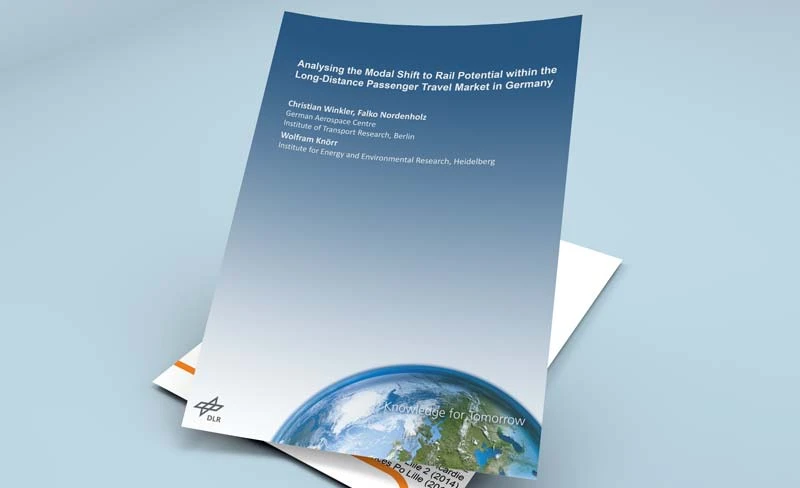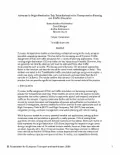-
Past ETC Papers

Browse, search and view papers from the past AET Conferences.
-
Members' Area

AET promotes networking and exchange of ideas, information and opportunities amongst members.
Conference Papers 2008
Noordwijkerhout, Netherlands
ETC Conference Papers 2008
Advances in origin-destination trip table estimation for transportation planning and traffic simulation
Seminar
Day 1 (6 Oct 2008), Transport Demand Modelling, OD Matrix Estimation, 11:00 - 13:00
Status
Accepted, documents submitted
Authors
R Balakrishna, D Morgan, A Rabinowicz, H Slavin, Caliper Corporation, US
Short abstract
Travel demand matrix estimation using traffic data is a critical yet challenging part of model-building. We discuss approaches to obtain static and dynamic trip tables and present real applications that demonstrate emergent estimation methodologies.
Abstract
Origin-destination (OD) trip matrices are crucial inputs for travel demand forecasting and traffic simulation, and may be estimated from traffic measurements such as counts. Many methods are available for estimating static OD matrices that contain total trip rates for extended peak and off-peak time periods. Early methods used trip distribution models of the gravity or entropy family and were estimated with linearized equations and least squares followed by non-linear least squares (or by maximum likelihood). These methods may tend to obscure practical difficulties such as measurement error, missing counts, and spatial-temporal inconsistencies. More than one solution may therefore provide a reasonable fit to the observed counts. Some methods therefore attempt to remain close to a seed matrix to ensure a reasonable solution. Methods based on equilibrium traffic assignment (such as the one by Nielsen) seek consistency with route choice behavior so that an assigned OD matrix closely mirrors the measured counts. Though computationally more intensive, these have become practical due to improvements in computing power.
Despite widespread use, static OD estimation has limitations. Each matrix is assumed to be assigned and the trips completed within the same time period, leading to inconsistencies from trips that span more than an interval. Conventional static assignment also cannot account for over-saturated conditions. Further, equilibrium assignment path flows are not unique, suggesting that the estimated OD matrices are also not unique. Finally, since link volumes and speeds are dynamic over time, there is aggregation error in the use of long time periods.
Short-term planning and traffic simulation require dynamic OD tables in order to accurately model peaking, queue formation and dissipation and spillbacks. Such tables represent trip departure rates during short time intervals such as 5 or 15 minutes. Dynamic OD profiles derived from one or more static OD tables are often not based on traffic measurements; such methods need not reflect real-world traffic dynamics, and may be unrealistic. Time-varying traffic sensor measurements are collected automatically, represent recent network conditions and contain information about dynamic OD patterns. It is therefore logical to divide the analysis period into short departure time intervals and estimate a set of OD matrices that replicate the time-varying data.
The most popular dynamic OD estimation method uses assignment matrices that are linear approximations of the mapping between OD flows and link counts. Assignment matrices may be computed using the output of a mesoscopic or microscopic traffic simulator or a dynamic traffic assignment (DTA). Since these mappings are linear, the solution of the unconstrained OD estimation problem using traffic counts is conceptually simple. However, costly fixed-point iterations are required to ensure that the input assignment matrices are consistent with the output OD flows. Further, the simultaneous estimation of OD flows for all intervals requires the inversion of a large block-diagonal assignment matrix that has been shown to be prohibitively expensive. The general approach thus has been to estimate the OD matrices one interval at a time while fixing the estimated flows in all previous intervals. This sequential method, though computationally attractive, can break down on congested networks with long trips or short time intervals. Further, the assignment matrix provides an intuitive mapping between OD flows and link counts, but is harder to employ in the context of other data such as speeds or travel times.
Gradient-based and response surface methods have recently been used to solve for dynamic OD flows without imposing linear approximations or using the sequential approach. The mappings between any general traffic data (counts, speeds, travel times, etc.) and the OD flows are directly captured with an assignment model of any fidelity desired by the modeler. The method provides a practical solution to simultaneously solve for the OD flows of several departure time intervals.
Two dynamic OD estimation methods were recently compared on the same dataset from downtown Los Angeles. The numerical results illustrate the benefits of simultaneously estimating the OD matrices for all departure time intervals at once, and moving away from linear approximations. On-going tests on another example in California involving two classes of vehicles (single- and high-occupancy) also indicate the potential of the non-linear approach. Nevertheless, dynamic OD estimation remains a challenging exercise owing to sparse sensor coverage, poor data quality and limited real-world applications. More tests on a wide range of networks are required before any method (existing or new) can be reliably adopted in practice.
Documents:

Association For
European Transport
Forester House
Doctors Lane
Henley-in-Arden
Warwickshire, UK
B95 5AW
+44 (0) 15 64 793552
VAT number: 710 1866 64
Conference Supporters & Endorsers




Legal Entity
The Association for European Transport is registered as an Association ('vereniging') with the Chamber of Commerce for Haaglanden in The Netherlands under company number 27170096.
Built on Zenario




